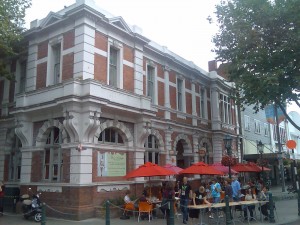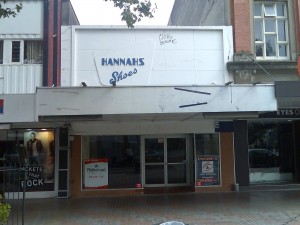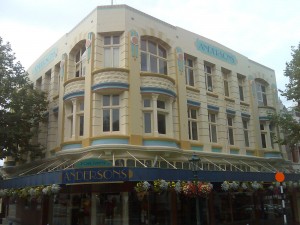Welcome back to work, and welcome to 2013. It’s going to be a big year.
Why? Well, apart from the battle for the soul of the city – flyover proponents vs those who favour something else (read more here), there is also going to be a shake-up in the Building Code over the issue of Seismic strengthening.

Yes: MoBIE strikes again – submissions are called for on the issues of What should we strengthen, How high is the new strengthening level, When do we have to strengthen it to, and lastly but certainly not leastly – Who pays for the strengthening? Check out and download the document at this DBH/MoBIE site. Closes 8th March – you have 2 months for your comments. To help you on your way, let’s discuss them briefly here. The proposals are:
1. Local authorities would be required to make a seismic capacity assessment of all non-residential and multi-unit, multi-storey residential buildings in their districts within five years of the legislation taking effect, using a standard methodology developed by central government, and to provide the resulting seismic capacity rating to building owners. An owner could have their building’s seismic capacity rating changed by
commissioning their own engineering assessment.
2. Assessments would be prioritised faster for certain buildings (eg, buildings on transport routes identified as critical in an emergency).
3. Building information would be entered onto a publicly accessible register maintained by MBIE.
4. The current national earthquake-prone building threshold (one-third of the requirement for new buildings, often referred to as 33 per cent NBS) would not be changed. However, it is proposed to establish a mandatory national requirement for all buildings to be strengthened to above the current threshold, or demolished, within a defined time period.
5. All buildings would be strengthened to be no longer earthquake-prone, or be demolished, within 15 years of the legislation taking effect (up to five years for local authorities to complete seismic capacity ratings, followed by 10 years for owners to strengthen or demolish buildings).
6. Strengthening would be carried out faster for certain buildings (eg, buildings on transport routes identified as critical in an emergency).
7. Owners of buildings assessed as earthquake-prone would have to submit a plan for strengthening or demolition within 12 months.
8. Certain buildings could be exempted or be given longer time to strengthen, eg, low-use rural churches or farm buildings with little passing traffic.
9. Central government would have a much greater role in guiding and supporting local authorities and building owners, as well as in public education and information.
But there are further proposals as well, that need to be focused on, for that relates greatly to the urban design, heritage, and future appearance of our cities. Although these questions are tacked on as an addendum, to many people, these will actually be the most important points to discuss, keeping in mind this following (truncated) graph:

(click on graph to enlarge and see details – if your district or council isn’t there, then it will be in that middle zone…)
25. When considering listing heritage buildings on district plans, what factors should local authorities consider when balancing heritage values with safety concerns?
26. What assistance or guidance will be required for owners, local authorities and communities to make informed decisions on strengthening heritage buildings in their districts?
27. What barriers deter heritage building owners from strengthening their buildings?
28. Do heritage rules (for example, those in district plans) deter owners from strengthening heritage buildings?
29. What are the costs and benefits of setting consistent rules across the country for strengthening heritage buildings?
Looking more closely at that graph, and zooming in, we can see that while Wellington has done by far the most work on examining its stock of commercial buildings, Auckland still has a massively long way to go, but so far is not too badly off in terms of finding seismically-prone buildings – as a total proportion of its stock it is quite a small total, although of course that is still a very large number of buildings. Auckland, with its massive resources and population base, may be able to save some of those buildings. Wanganui, on the other hand, is doomed:

(Click to enlarge)
As a total proportion of the commercial building stock, Wanganui (or Whanganui) appears to have about 300-400 quake-prone buildings out of about 1300 buildings in total, with about that number again not even looked at yet. While other cities (such as Rotorua) haven’t even started looking at their building stock yet (Hurry Up Rotorua!), at least Wanganui is being honest with itself – even if it does not like the answer. Some buildings have already closed down.

A lot of those buildings will have to close their doors for good, very soon, as (my guess) is that there is simply not enough money in the local economy to afford to strengthen them. As a mainly Victorian-era town, with lots of fine brick buildings, many of which are already suffering from lack of maintenance, then (barring a miracle) we are likely to see about a third of the city of Wanganui demolished over the next 5-10 years. Some of these buildings we won’t miss.

Wellington is not in quite such a parlous state, but it is still facing devastation of its heritage building stock. While WCC still has about 1700 buildings to assess out of about 5500 total, so far they have only discovered about 300 that are quake-prone. As a proportion, that is far better odds than Wanganui – but would still be devastating for this city. As a nation therefore, we face a question – do we value our architectural heritage? If the answer to that is in any way Yes, then the next question has to be – how can we save it?

Of course, the sad truth is that the plain, ugly, monstrously stupidly-designed buildings are quite possibly not earthquake-prone in any way – whereas the pleasantly proportioned, nicely detailed, quaint brick-based buildings that give the city it’s character are the ones most under threat. Suggestions on how to save this heritage welcome please!
Please note: the buildings illustrated above are all Wanganui building stock, but no inference should be taken that any of them are earthquake prone or not. They merely illustrate some of the range of building types at present existing in Wanganui.


Leave a Reply